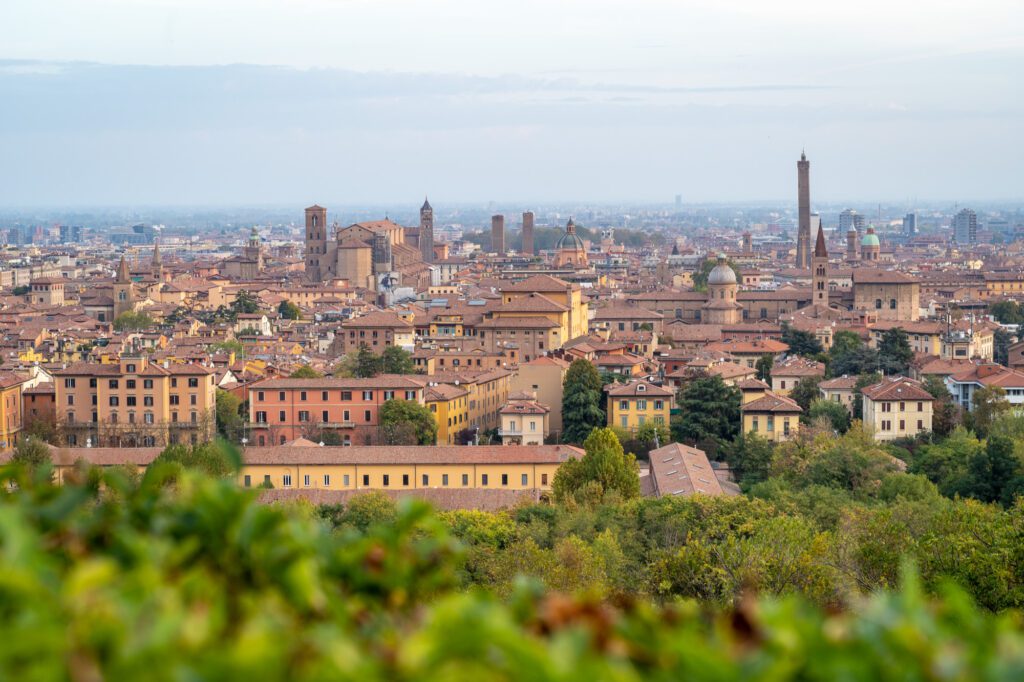One Day In Bologna: See the Best of Bologna in a Day
Generally speaking, Bologna isn’t really on most top 10 lists of Italian cities to visit. However, after a couple of trips to Bologna (with more in our future, I’m sure), we’re here to convince you to spend at least a day there on your next trip to Italy.
With its central location and great transportation links to many other nearby cities, it’s super easy to incorporate the city into your trip to Italy (like we’ve done in our two week Italy itinerary) and it actually makes a great home base for exploring central and northern Italy.
We only stumbled into our love for Bologna because we have friends who relocated to Italy from the U.S. and chose Bologna as their new forever home.
We went to visit them on a day trip and spent the better part of a day wandering around the streets of Bologna, learning about their new life and love for their adopted city.
We fell in love, especially with the food, and made plans to return ASAP (which came to fruition almost exactly a year later when Matt spent almost a week in Bologna).
There are countless reasons to visit this underrated Italian city, but we can best sum it up through its three nicknames – la Dotta (the wise), la Rossa (the red), and la Grassa (the fat or the fat one).
La Dotta (the wise) refers to the fact that Bologna is home to the oldest university in the world and is still a lively university city to this day. The large student population – a big chunk of the population of Bologna – brings a youthful energy to the historic city that gives it a unique vibe compared to other cities in Italy.
La Rossa (the red) refers to the striking red brick buildings and terracotta rooftops that are typical of Bologna. You can catch a glimpse of the iconic rooftops from one of the slender medieval towers that dominate the city’s skyline (don’t worry, we’ll get to that).
Last, but CERTAINLY not least, la Grassa (the fat) refers to Bologna’s reputation as the food capital of Italy. Bologna sits at the heart of Italy’s bountiful Emilia-Romagna region, which is known for producing many of Italy’s most popular delicacies and dishes (namely prosciutto di Parma, Parmesan-Reggiano cheese, and Balsamic Vinegar from Modena).
It’s also the home of traditional Bolognese Ragù. Which, after eating it in Italy and re-creating it at home, is not simply ground beef and Prego tomato sauce like my mom makes.
Instead, it’s a delectable, complex combination of slow-simmering ingredients that takes hours and hours to make right. In fact, there’s only a very small amount of tomatoes in it at all, which blew our minds.
Anyway, the point is that Bologna is a fun, delicious destination to add to your trip to Italy, and we’re going to do our best to show you why we love it so much.
In this guide to spending one day in Bologna, we’re going to cover everything you need to know to visit Bologna for a day (either as an overnight or as a day trip from a city nearby).
We’ll start with some logistics, like how to get to Bologna and how to get around, and then go into a detailed guide to spending a day exploring the city.
Sound good to you? Let’s get into it.
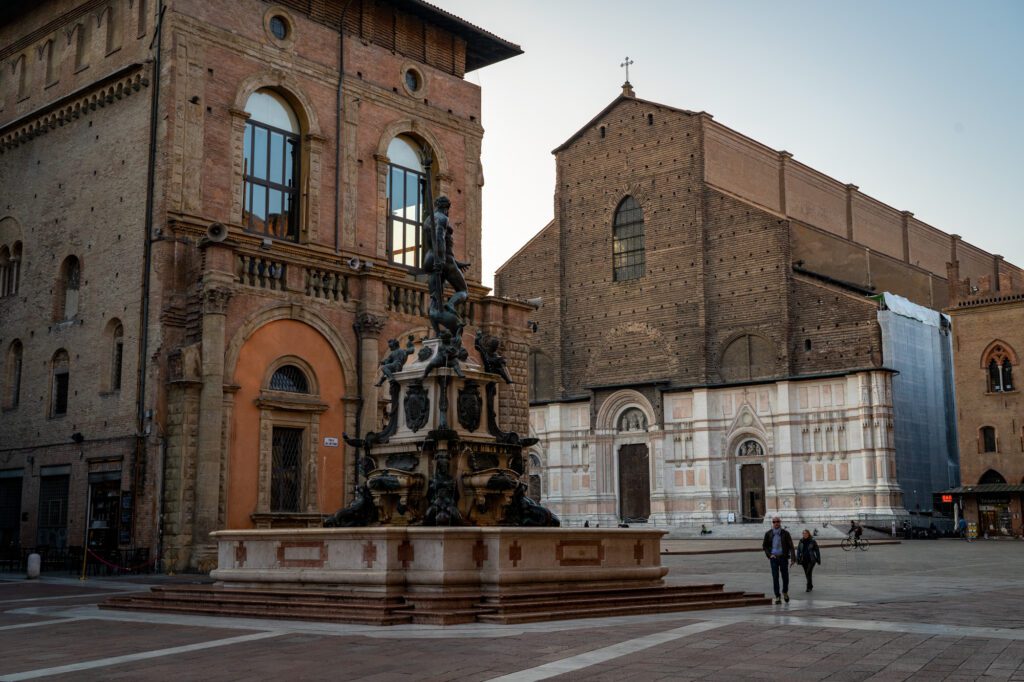
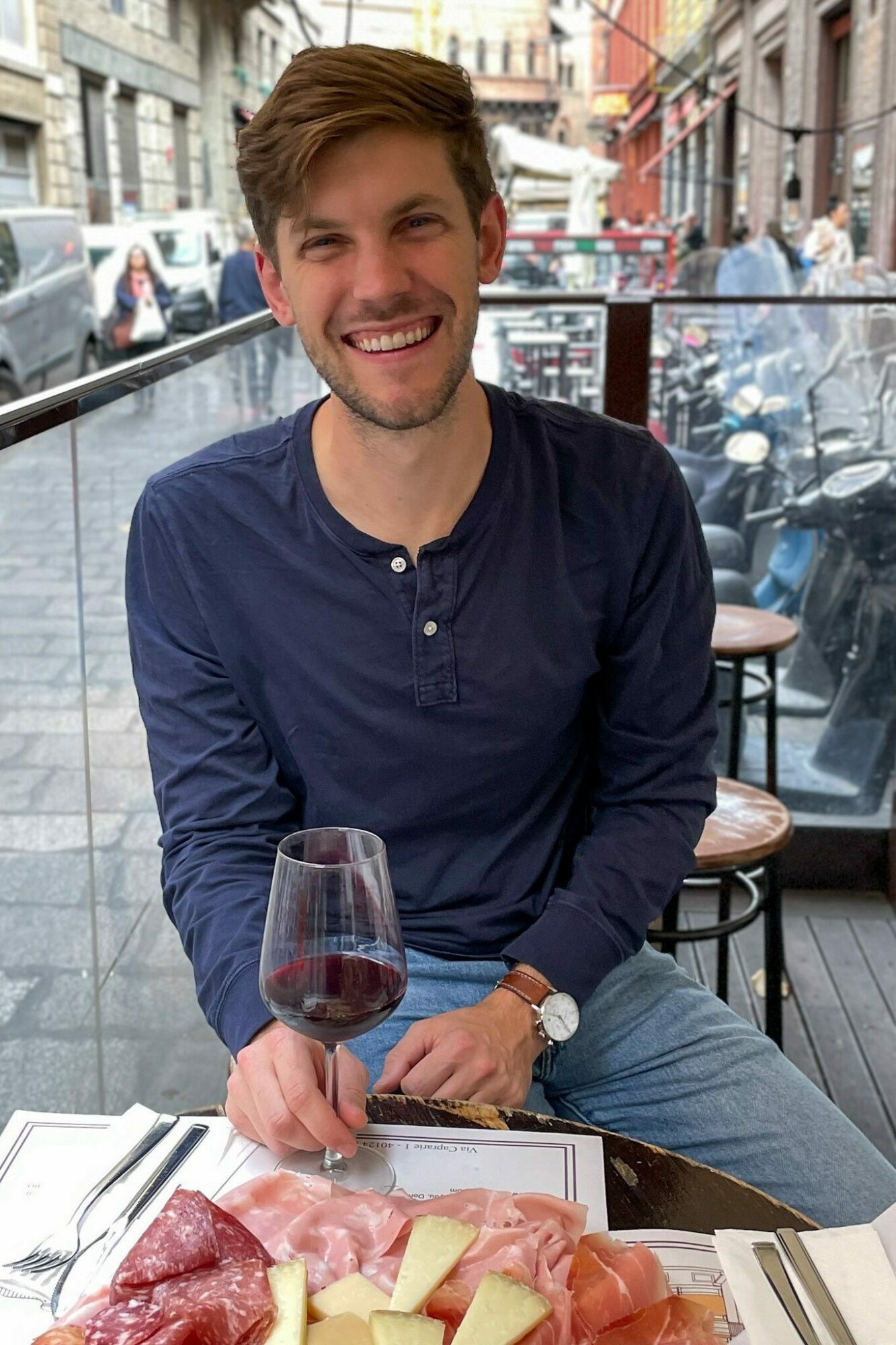
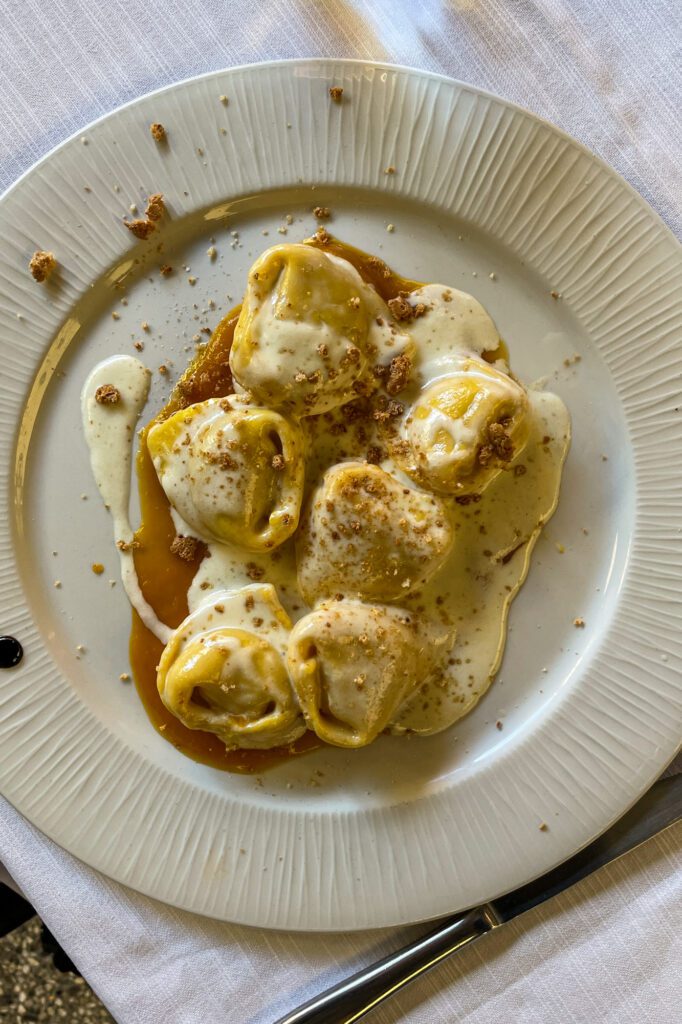
Disclaimer: Some of the links in this post, like hotel links, are affiliate links, meaning at no additional cost to you, we make a little bit of money if you click through and book. That being said, we would never recommend something to you that we don’t stand behind 100%.
Is One Day Enough Time?
Yes and no. On one hand, a day is enough time to get a taste for the city (we mean that literally and figuratively because this itinerary includes A LOT of eating).
Will you be able to see everything? No, definitely not. Will you be able to see enough so that you’re intrigued to plan a return trip ASAP? Probably.
How do we know that? Because that’s exactly what happened to us.
As we mentioned above, we first visited Bologna on a day trip from Florence to visit some friends who had recently moved from the U.S. to Italy.
That Bologna day trip gave us a nice overview of the city, and we immediately fell in love with it (at least partially because of the food). Exactly one year later, to the week, Matt made his triumphant return to the city to spend five days going a little deeper.
With one day, you’ll be able to see some of the highlights. On your next trip, there will still be plenty to do, see, eat, and drink (which is what our two day Bologna itinerary is for!).
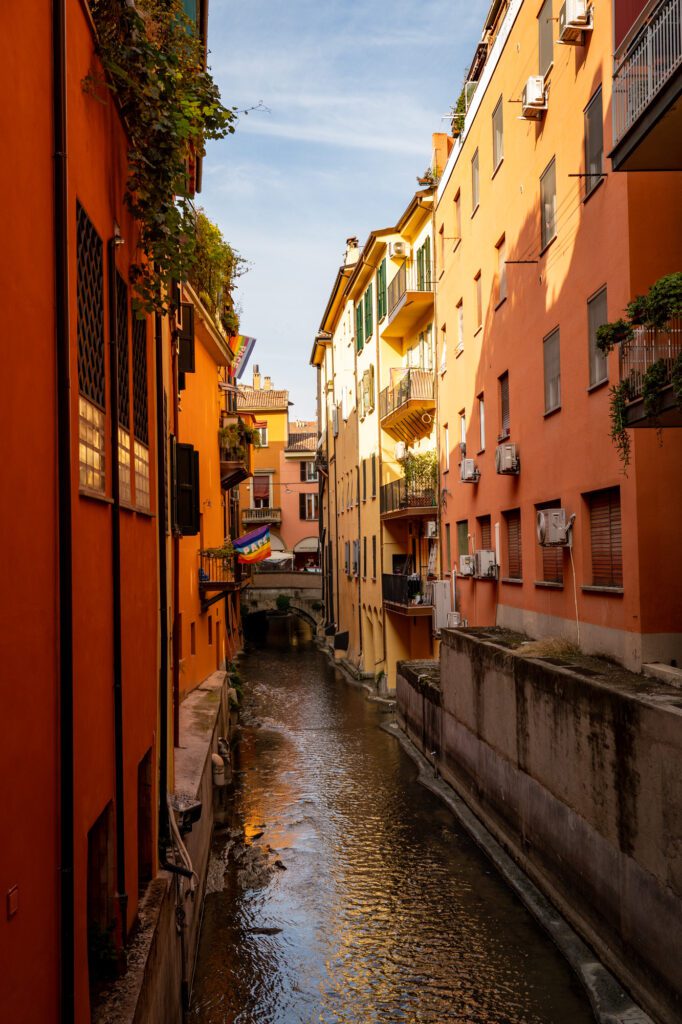
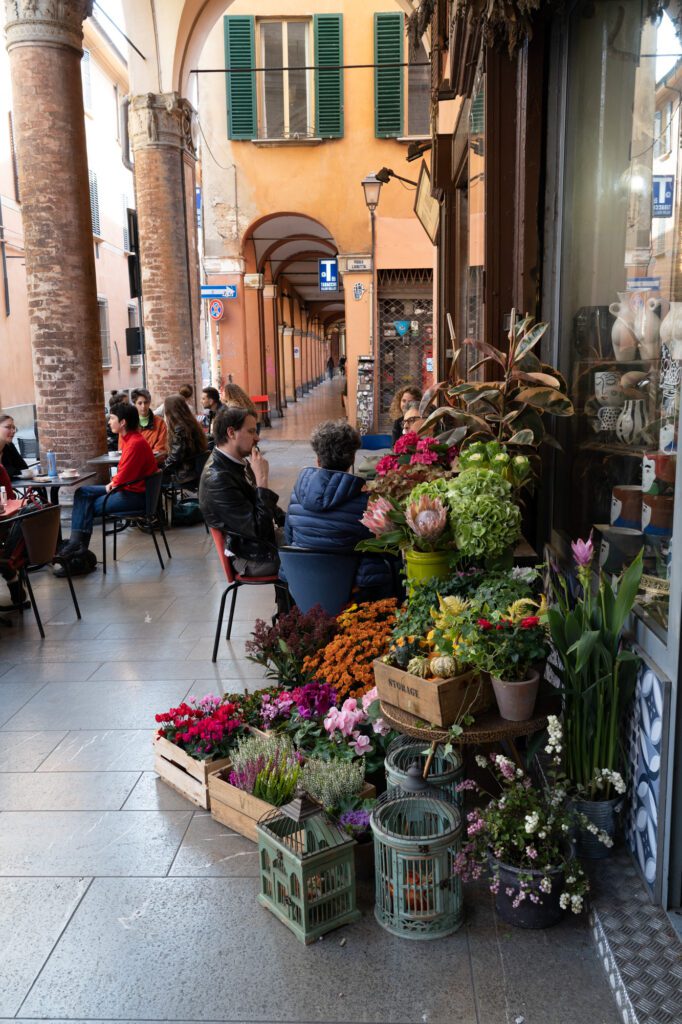
Exactly How to Spend One Day in Bologna
Based on our own experience exploring the city on multiple occasions, this itinerary will give you a fantastic insight into the history, architecture, and food of Emilia-Romagna’s relatively undiscovered capital.
For the purpose of this itinerary, you can either use it as a guide for planning a day trip (book an early and late train back to wherever you’re coming from!) or for a one night stay (for this, we’ll assume you’re arriving the evening before and leaving late in the evening/the morning after, so you have a full day to explore).
But First, Coffee
We like to start every day of every itinerary we write with coffee because when you’ve got a full day of exploring ahead of you, caffeine is going to give you a much needed turbo boost.
And because Matt loves coffee, and spends an inordinate amount of time searching for the best coffee shops in cities he visits.
Like everywhere in Italy, it’s not difficult to find great coffee in Bologna.
However, I (Matt, the resident coffee geek here!) would definitely say that finding good specialty coffee in Italy is a little more hit and miss. Italy is a lot more roasty toasty espresso, a lot less bright and fruity filter coffee.
My favorite coffee in Bologna came from Aroma Specialty Coffees, a cozy little cafe hidden within the porticoes just a few minutes west of Piazza Maggiore.
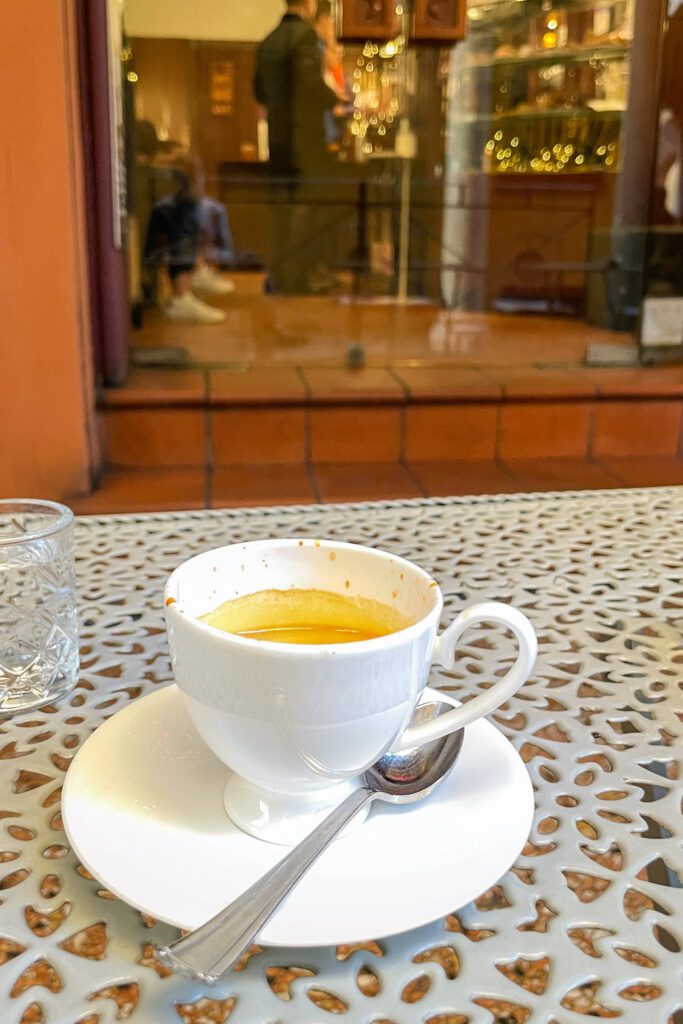
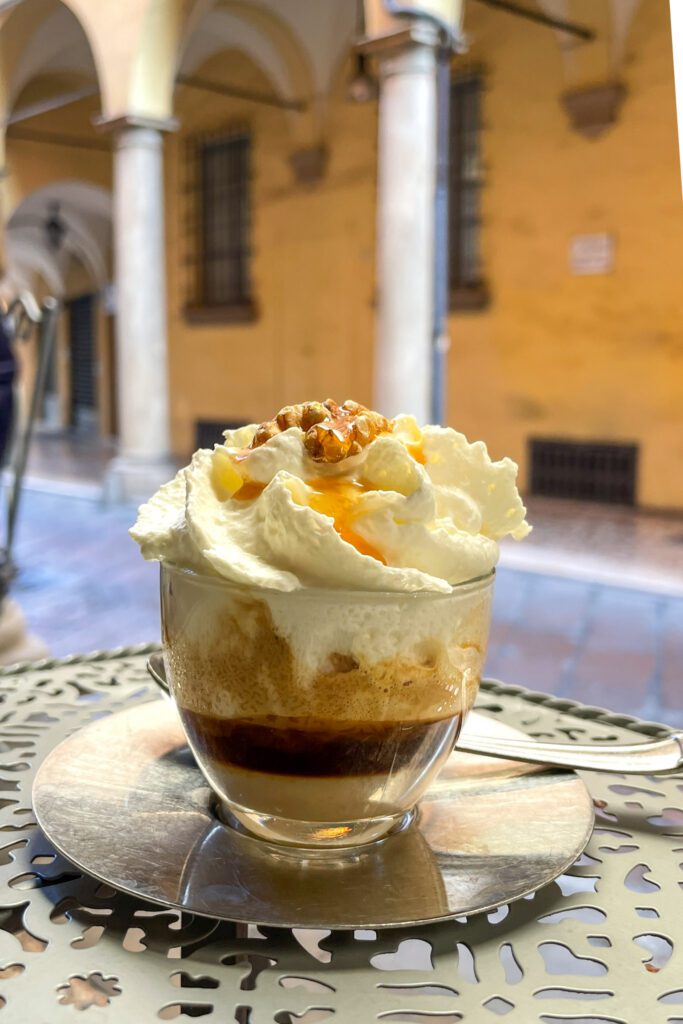
Owned by award-winning coffee brewer Alessandro Galtieri, the cafe offers a carefully selected menu of Italian specialty coffees, as well as more traditional coffee options and some fun flavored drinks.
There’s also a selection of freshly baked pastries and cakes available each morning.
You can stand at the bar to drink your coffee – like the Italians do – or sit at one of the little tables within the porticoes for a more leisurely breakfast.
We went to Aroma multiple times during our stay in Bologna, including to buy a bag of beans from Gardelli, my favorite Italian roaster.
Start Your Day at Piazza Maggiore
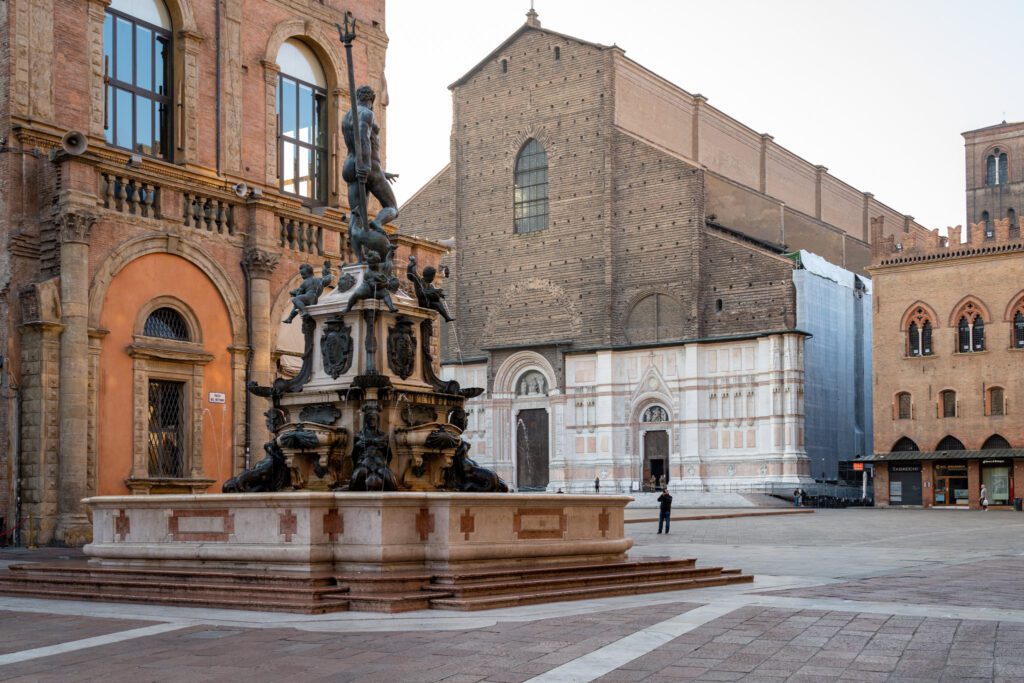
Once you’re good and caffeinated, your first stop of the day is the iconic Piazza Maggiore.
Piazza Maggiore is the beating heart of Bologna. Sitting at the center of the city, the lively piazza is full of people at all hours of the day, including many talented street performers who really bring the area to life.
Every single time I’ve walked through Piazza Maggiore, I’ve felt the energy reverberating off of every surface. There is often a different street performer with a small crowd encircling them and a collection of people sitting on the stairs out front of the cathedral relaxing in the sun.
Take a moment to admire the stunning architecture surrounding the square.
Piazza Maggiore is home to many of Bologna’s most impressive and important buildings, including the Palazzo d’Accursio (Municipal Palace) and the mighty Basilica di San Petronio (which we’ll discuss more later).
Admire the Fontana del Nettuno
While exploring Piazza Maggiore, don’t miss the adjacent Piazza del Nettuno and its famous 16th-Century Fontana del Nettuno (Fountain of Neptune).
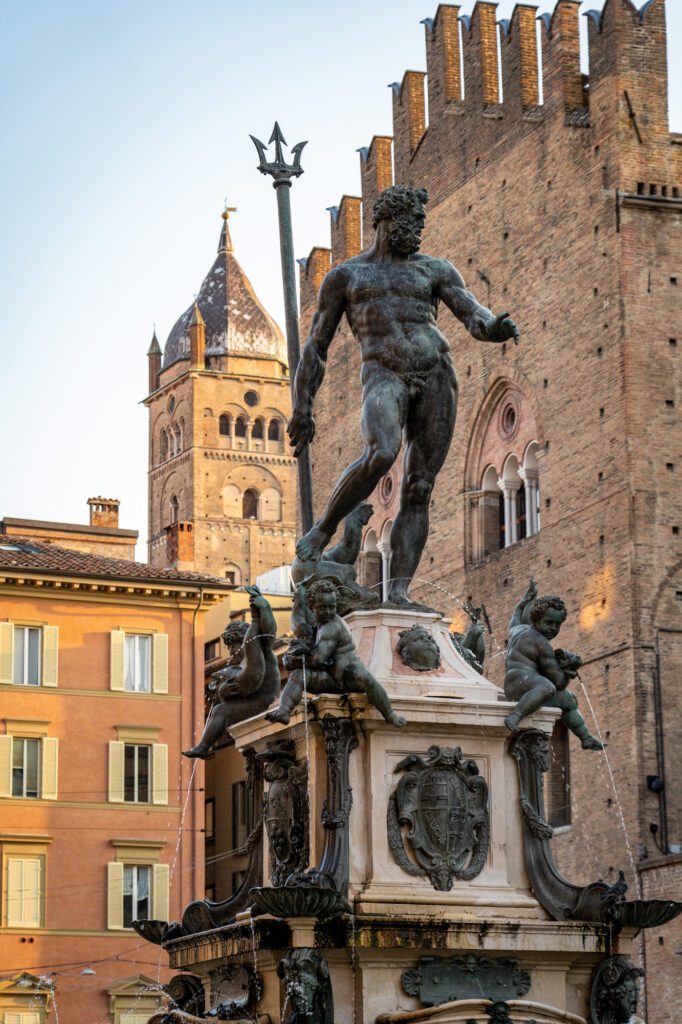
The large fountain is surrounded by mermaids and topped with a bronze figure of Neptune, the Roman god of the sea.
But there’s more to this fountain than meets the eye. The fountain was supposedly commissioned to symbolize the Pope’s power at the time, as he ruled the land like Neptune ruled the seas.
However, Pope Pius IV was concerned about various aspects of the statue and requested that the artists make changes to make it a little less risqué.
Annoyed by the church’s censorship, Giambologna obliged but got his revenge in secret. He sculpted the statue so that when it’s viewed from a particular angle, Neptune’s hand makes Neptune look particularly well-endowed.
You can see this risqué optical illusion by standing on a black stone in the piazza behind the statue, which is known by locals as ‘“the stone of shame.”
On a slightly more wholesome note, there’s also a local tradition in which students walk around Neptune’s fountain twice in anti-clockwise circles to bring good luck in exams.
Admire the Basilica di San Petronio
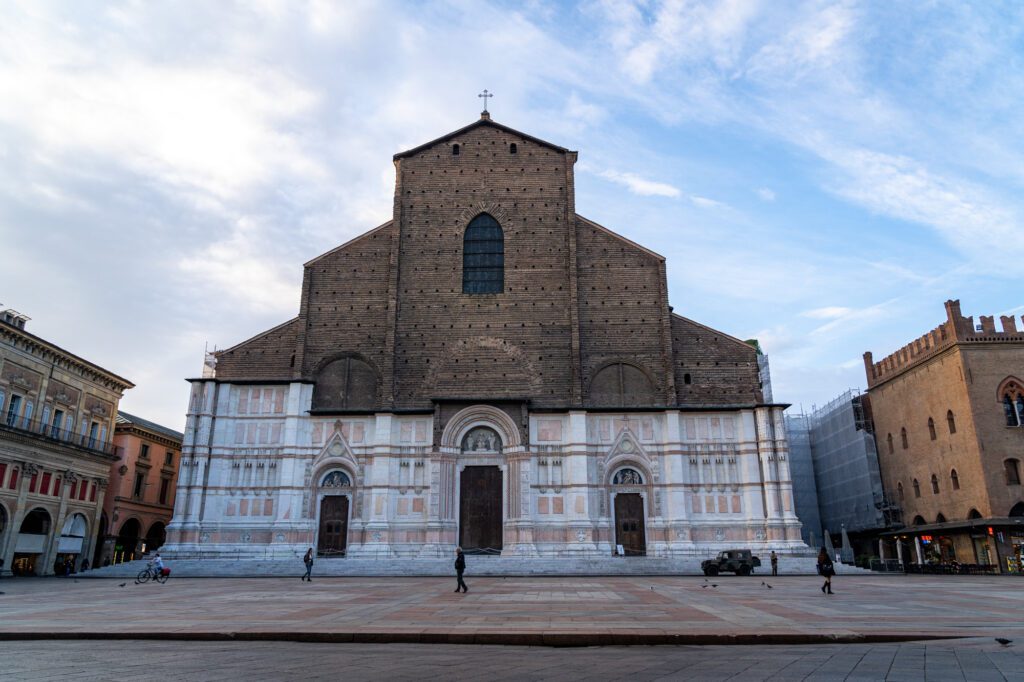
Standing in Piazza Maggiore, it’s also impossible to miss the unfinished facade of the monumental Basilica di San Petronio.
The huge 14th-Century basilica is a beautiful example of Italian Gothic architecture. However, the church’s exterior is only partially finished, which is evidenced by its unusual half-marble, half-exposed brick façade.
So why is the church only partially finished?
Well, Bologna tried to build a church that would outshine all others in Italy. The dream was to make it the biggest church in the world – yes, even bigger than the Vatican.
Unsurprisingly, the Pope was not happy with this and put a stop to the construction, resulting in the unique look today.
Despite the half-finished façade, the church is still the most important in Bologna and a must-visit. It’s completely free to head inside. However, you’ll need to pay €2 if you want to take any photos.
From inside, you can really appreciate the size and grandeur of the enormous church, with its 22 chapels and many priceless artworks. The Basilica also has the longest indoor meridian line in the world, at 67 meters in length.
Cattedrale Metropolitana di San Pietro
Basilica di San Petronio may be Bologna’s biggest and most famous church, but it’s not the city’s official cathedral.
Bologna’s actual cathedral, Cattedrale Metropolitana di San Pietro, sits just a few minutes walk away down the city’s main avenue of Via dell’Indipendenza.
The original Bologna cathedral dates back to the 10th-11th Centuries but has been altered dramatically over the years.
Today, it has a striking Baroque red brick facade that was added in the 1700s and is typical of the Italian city. While less imposing than nearby San Petronio, the large church is still worth stepping into.
The grand interior is free to visit and is home to many paintings by artists such as Prospero Fontana, Ludovico Carracci, and Donato Creti, while the church museum is a treasure trove of important religious items from the building’s history.
You can also climb the cathedral bell tower, which is the second tallest tower in the city at 70 meters. It costs €5 to climb.
Although the hours are a little hit or miss and definitely not what they have posted – at least not when we were there.
Climbing the Asinelli Tower
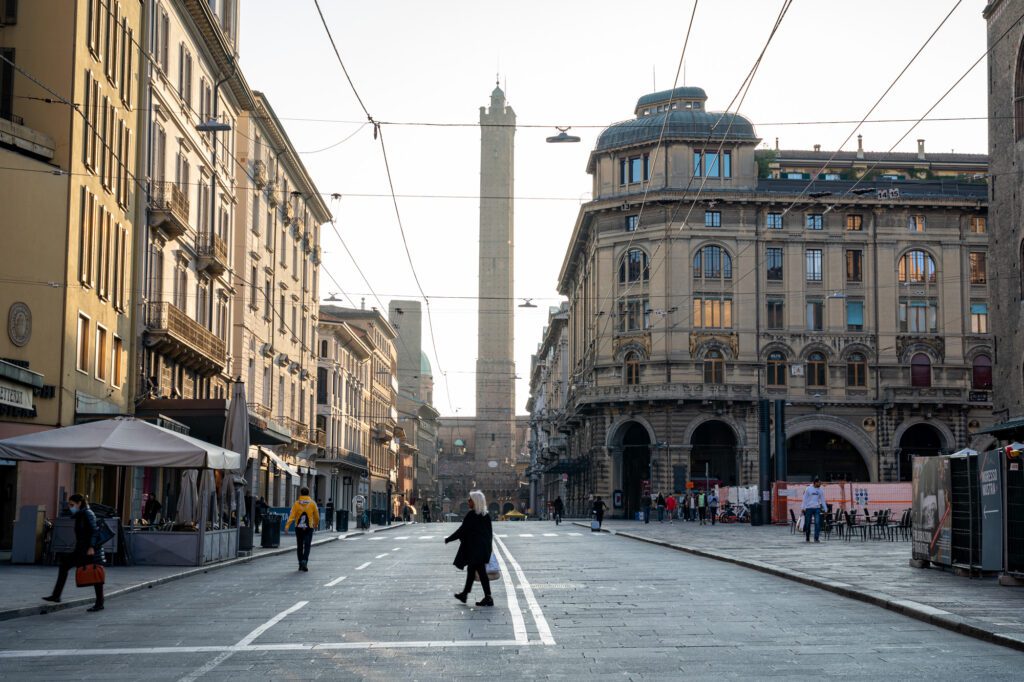
If you don’t manage to climb the bell tower of San Pietro, don’t fret. There’s an even taller tower just a few minute’s walk away, and it just so happens to be the next stop on this itinerary.
This is the first thing we ever did in Bologna, when we met our friends (who had lived in Bologna for a bit) to climb the tower, something they had never done before.
During the Middle Ages, Bologna’s skyline was filled with hundreds of slender medieval towers. These towers had both a defensive purpose and were a symbol of the wealth and social prestige of the family that had them built.
Many of the towers were torn down over the following decades, and today only a few remain. “Le Due Torre” – or “the two towers” – are the most famous of the city’s remaining towers and have become an iconic piece of Bologna’s skyline.
Asinelli is the taller of the two, at over 97 meters. Neighboring Garisenda once stood at the same height, but had to be lowered to 47 meters due to its increasing inward lean. It’s even been nicknamed “the Leaning Tower of Bologna.”
You can climb up the taller tower for spectacular panoramic views over the city.
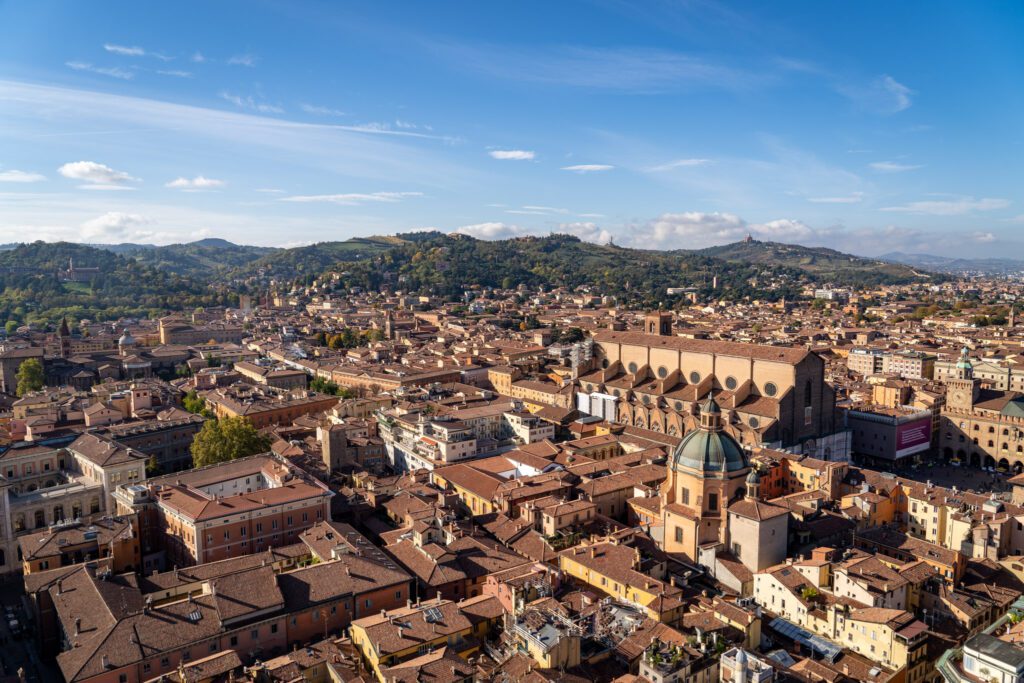
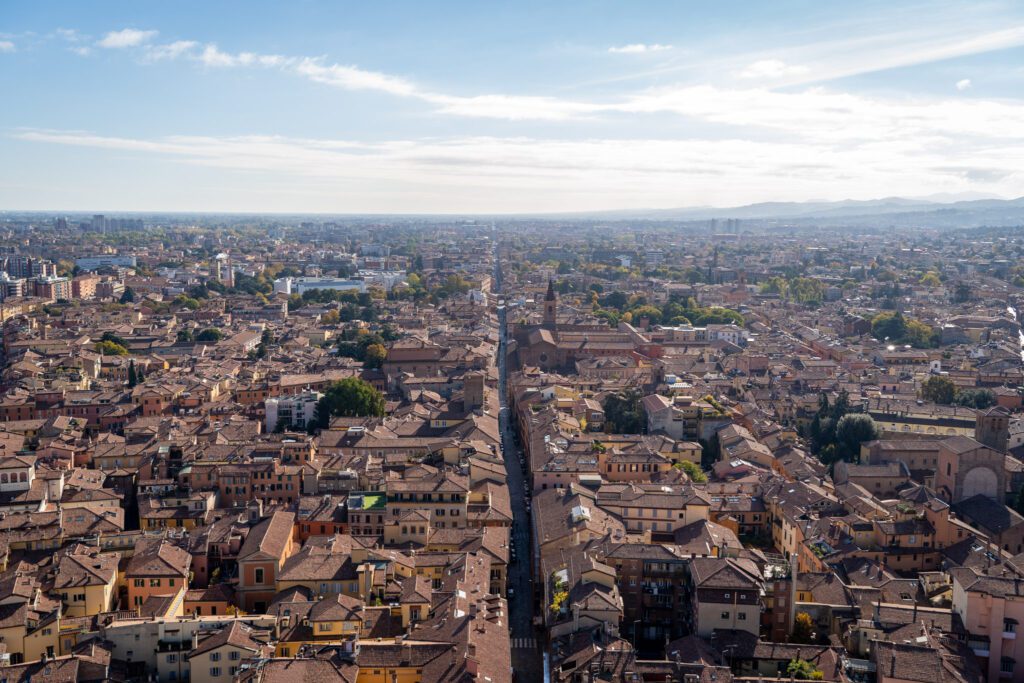
To reach the top, you’ll need to climb 498 steep steps up a winding wooden staircase. It’s not the easiest climb, but worth it for the breathtaking views!
The tower costs €5 to climb. Only a limited number of people can enter the tower at a time, so it’s best to book your tickets and time slot online in advance or you may be disappointed.
Lunch in Quadrilatero
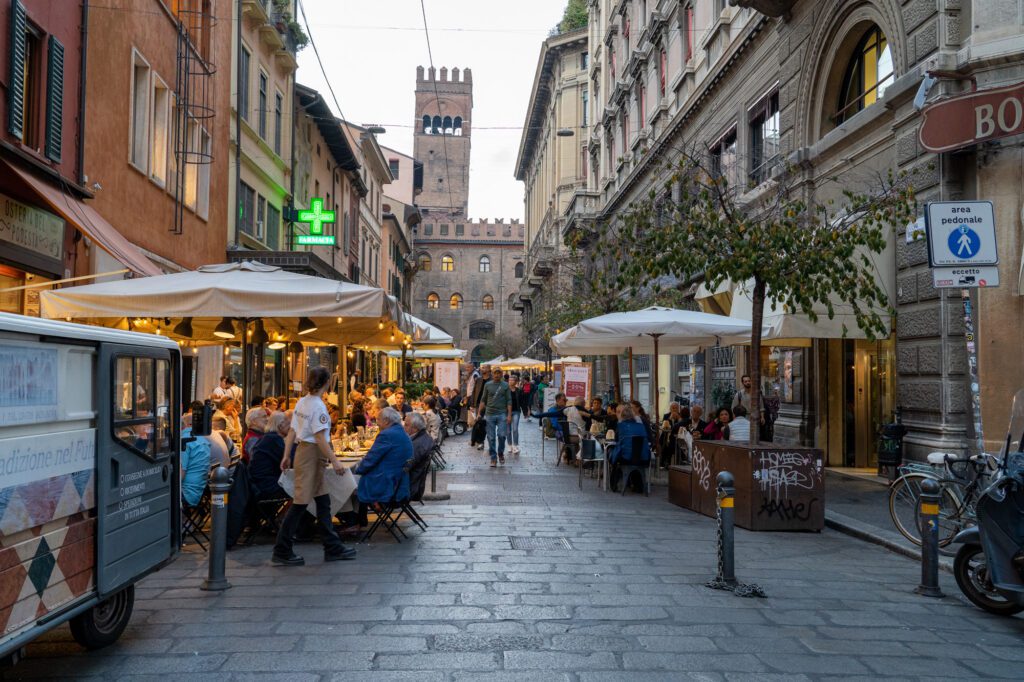
After a busy morning of exploring historic Bologna, you’ve probably worked up quite the appetite. So it’s finally time to make the most of the city’s world-renowned food scene.
Sitting just off Piazza Maggiore, Quadrilatero is the city’s historic food quarter and, in our opinion, one of the best neighborhoods for foodies in all of Italy – we know that’s a big claim but just wait until you experience it for yourself.
The compact neighborhood with narrow pedestrian-only cobblestone streets is packed with countless incredible market stalls, delis, shops, cafes, and restaurants. You can grab lunch here and browse for souvenirs of the edible kind to take home with you.
You can’t go too wrong no matter where you choose to eat in Quadrilatero, but here are some of our top suggestions anyway:
- Zerocinquantino is a charming little wine bar and restaurant with a fantastic selection of freshly made sandwiches, piadina, tigelle (local flatbreads typical of Emilia-Romagna), cold cuts, cheese, and small plates. It’s ideal if you’re looking for a light local lunch rather than a full meal. The bar is extremely popular and always busy with both locals and tourists. You’ll need to be assertive to get a table at lunchtime, but it’ll be worth it – trust us!
- Drogheria Gilberto is another wine bar and shop nearby that we went to that offers small plates featuring meats and cheeses. This may be one for the more adventurous eater – when we asked what one of the meats was, the server said “You don’t want to know.” If you have a sweet tooth, there’s also a great selection of Italian chocolates and sweets available in the shop.
- Tamburini is a famous deli and wine bar that’s been a Bologna staple since it first opened in 1932. The bar offers a fantastic selection of Italian cured meats and cheeses, traditional Bolognese dishes, and an array of homemade desserts.The shop is also a great place to pick up some local packaged foods like traditional cold meats, tasty cheese, and amazing local wines (we got our favorite bottle of lambrusco from the shop here).
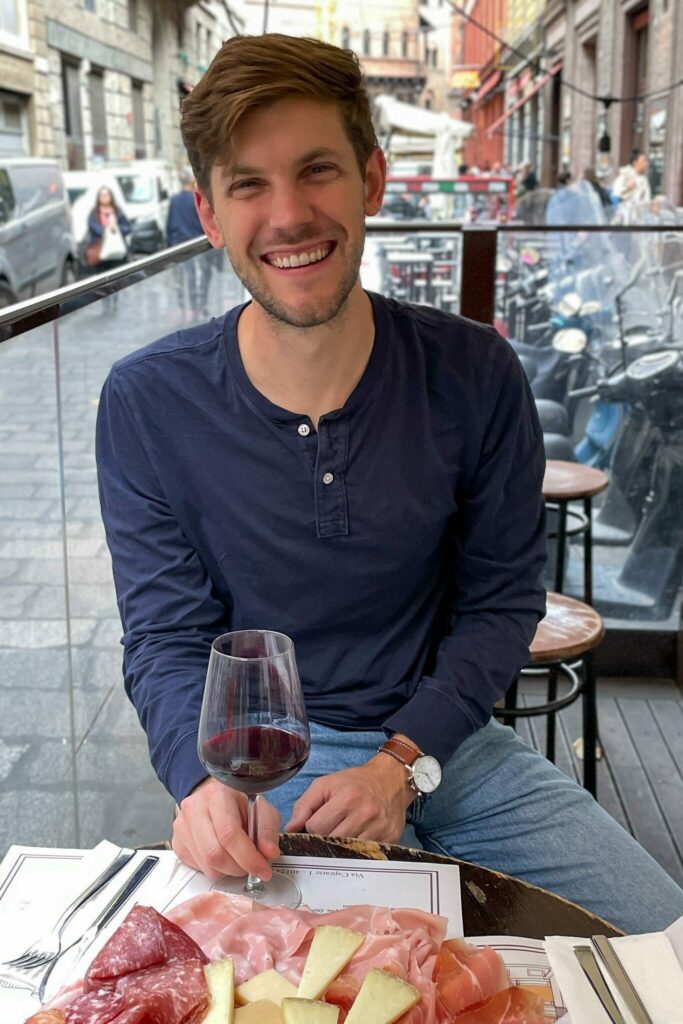
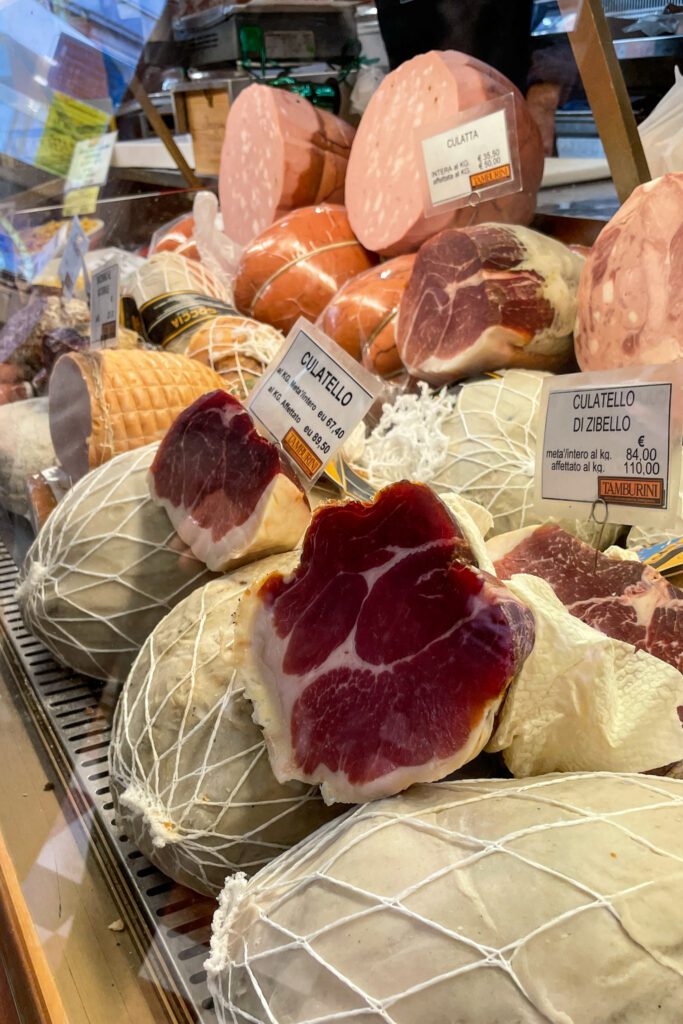
Cremeria la Vecchia Stalla
If you’ve still got any room left at the end of lunch, head to Cremeria la Vecchia Stalla for the best ice cream – not gelato – in Bologna. Multiple Bologna residents pointed me here as a “can’t miss” place to eat.
The ice cream shop has a huge variety of flavors to choose from, from more traditional flavors like pistachio and stracciatella to many unique and interesting flavor combinations that rotate regularly.
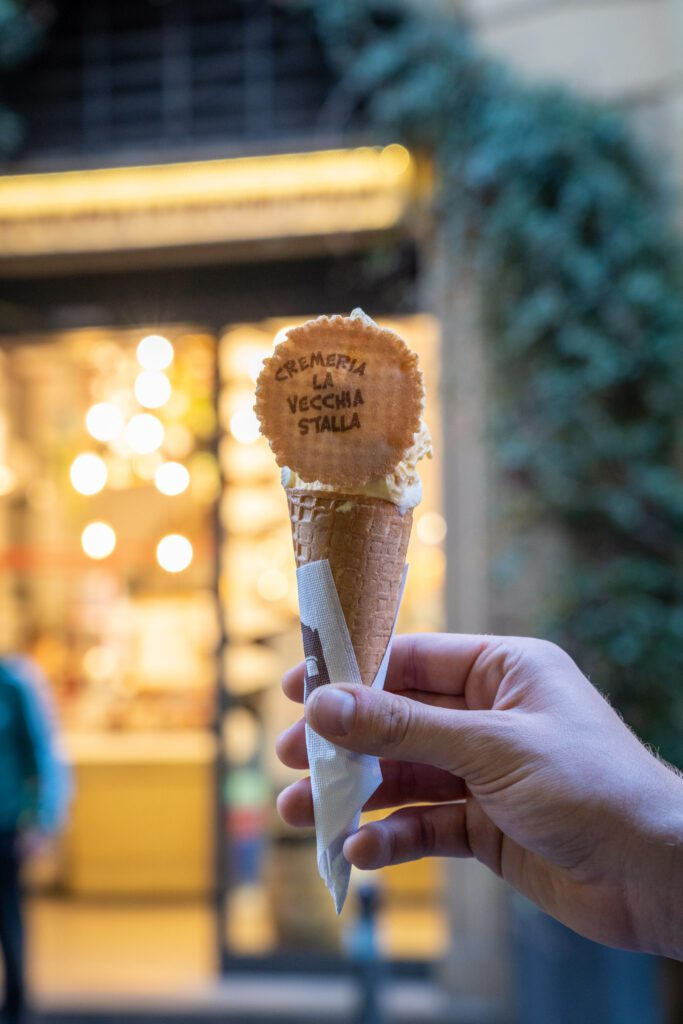
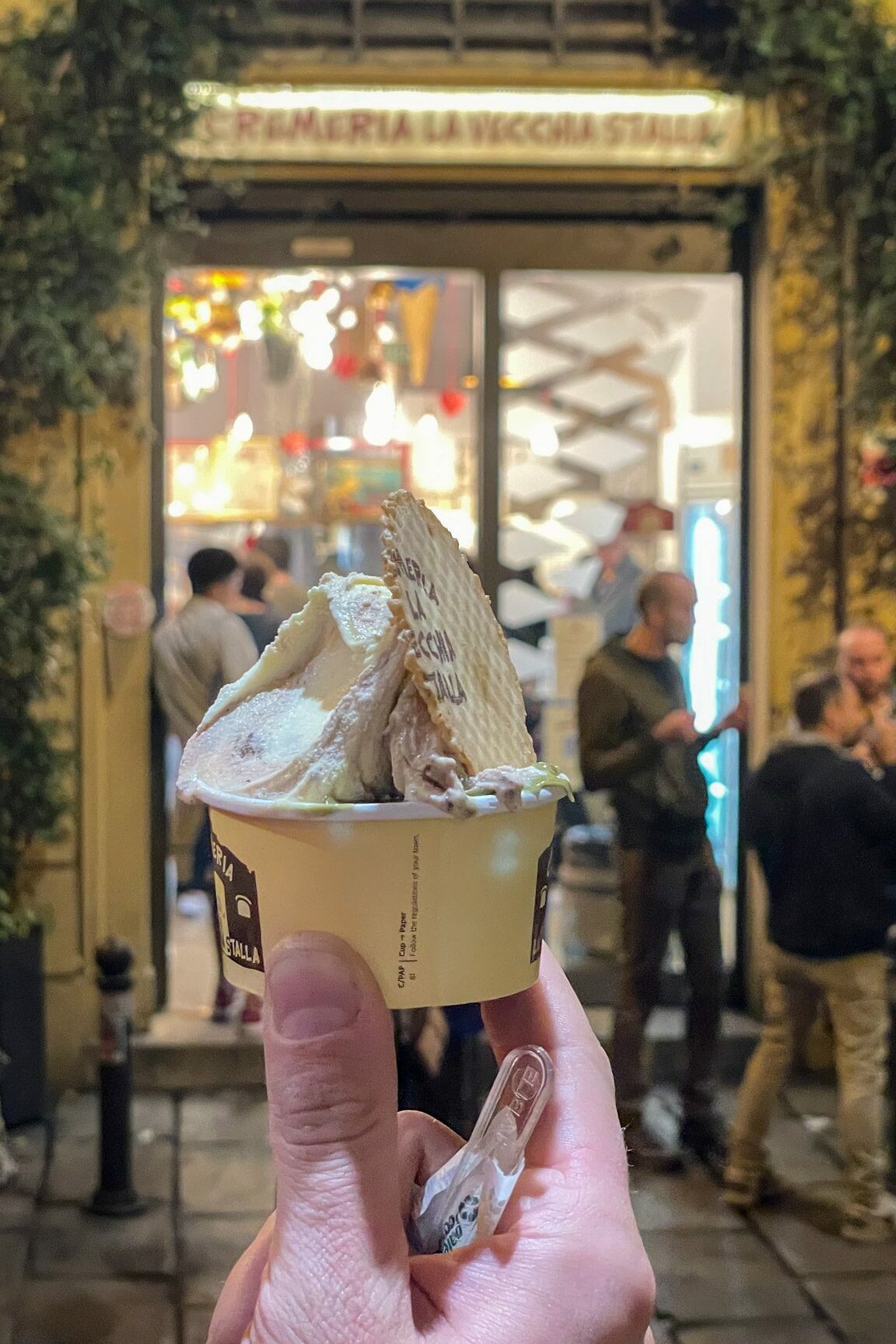
The shop is extremely popular and there’s often a line out the door. But the service is quick so you won’t be waiting too long for your ice cream.
Needless to say, we went multiple times over the course of a few days in town.
Complesso delle Sette Chiese
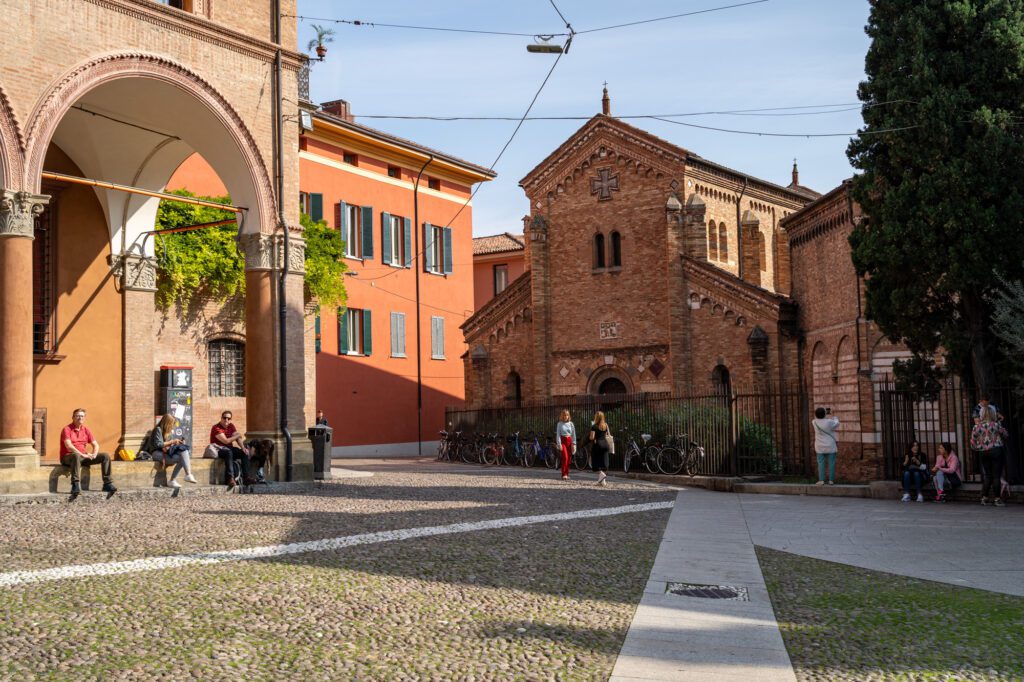
For your final historic attraction of the day, head just down the road to “Complesso delle Sette Chiese”, aka “Complex of the Seven Churches”.
Located on Piazza Santo Stefano, this unique religious complex encompasses a series of connecting churches, chapels, courtyards, and crypts that were built over multiple centuries. The origins of the unusual complex are highly disputed.
One story claims the original structure was built in the early 5th Century by Bishop Petronius over the ruins of a temple dedicated to the goddess Isis.
Petronius wanted a building that represented the Church of the Holy Sepulchre in Jerusalem, with the places in the Holy Land that recall the Passion, Death, and Resurrection of Jesus Christ. But it didn’t quite go according to plan.
On a visit to the complex, you can explore different periods of Bologna’s history, with evidence of Roman, Byzantine, Lombard, Ottonian, and Benedictine influence on the buildings as they were reconstructed over time.
There’s also a museum displaying frescoes, sculptures, and other artworks from various eras.
Entrance to the religious complex is completely free, but donations are welcome. You can purchase a small guidebook explaining what you’re looking at for just €2, which is definitely helpful to have as signage in English is limited.
An Evening Food Tour
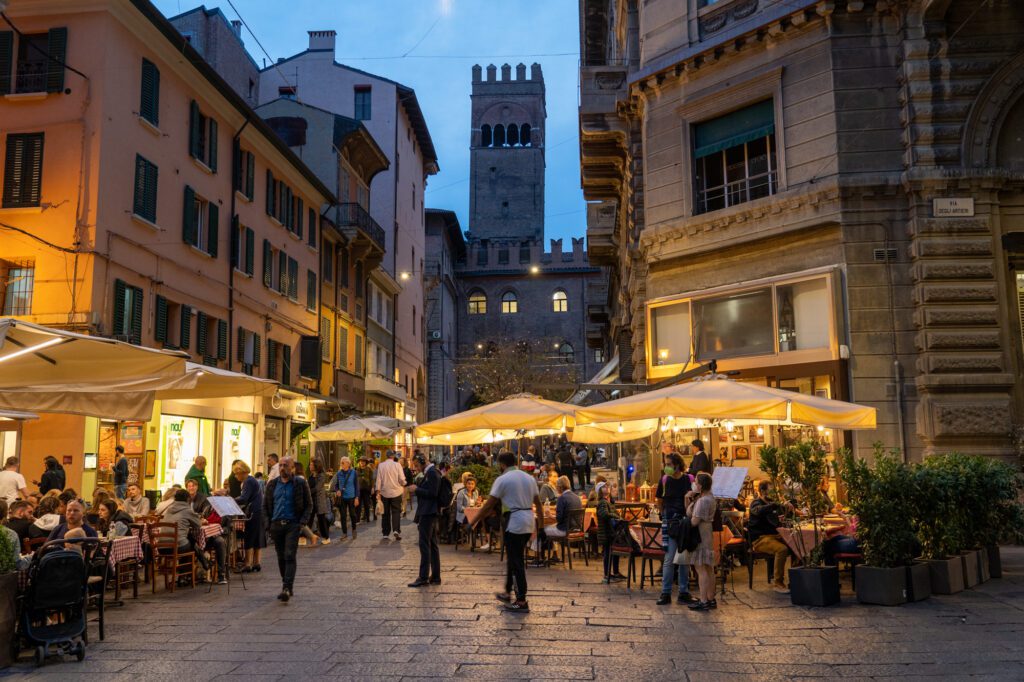
With only a day, one of the biggest challenges is trying to eat as much delicious local food as you can.
There’s no better way to experience a city’s food culture than spending a few hours with a local and seeing it through their eyes.
On a food tour, you’ll gain a deeper understanding of the city, its history, and its food culture. But most importantly, you’ll be taken to plenty of places to eat and drink that you would never discover on your own.
This is the food tour we’d do, but unfortunately, we had to skip it because Matt has Celiac Disease and can’t have gluten, which is present in basically everything that we would have eaten on the tour.
The 4-hour evening tour is run by a local and takes you on a journey to discover why Bologna is called the food capital of the world.
You’ll get to visit a food market, attend an artisanal pasta workshop, sample Balsamic vinegar of Modena, and taste many local specialties like mortadella, Parmigiano, tagliatelle al ragù, tortellini, and local wine (including lambrusco, the delightful bubbly and light red wine that calls Emilia-Romagna home).
What to Do with More Time in Bologna
If you do find yourself with more time, there are plenty of other things you can see and do to expand your trip.
The first thing we’d do is head straight to our guide for two days in Bologna, which has everything you need to know to add an extra day (and plenty of extra food) to your itinerary.
Hike up to the Santuario Madonna di San Luca
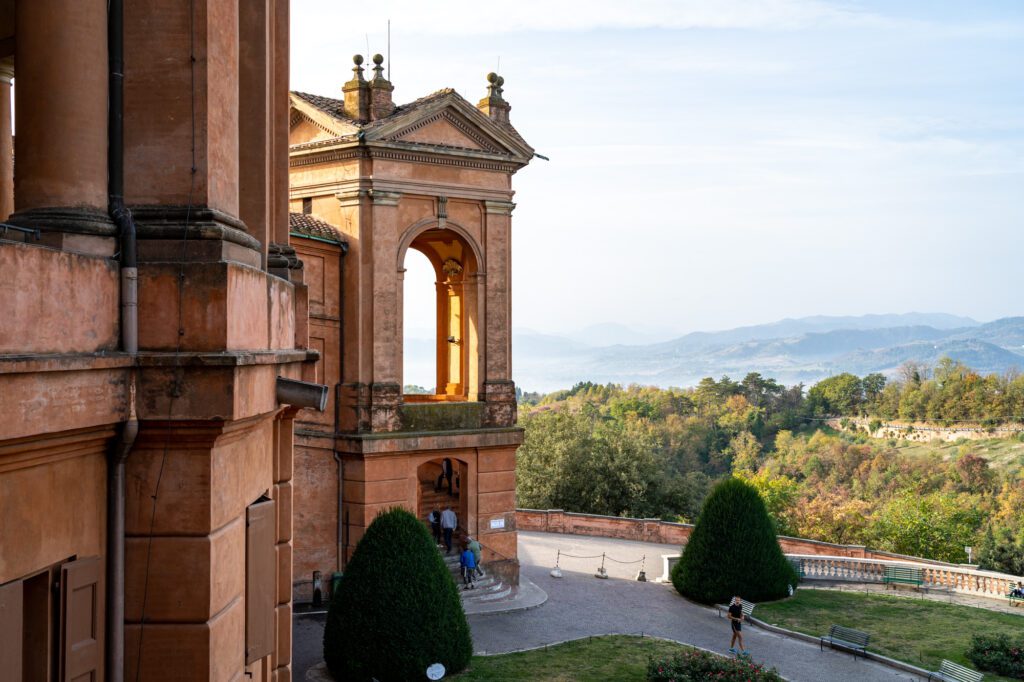
The first thing to add to your trip to Bologna is a hike up to the Santuario Madonna di San Luca, which was the #1 recommendation from our friends that live in Bologna.
The grand baroque church sits on a hilltop above the city. Taking a pilgrimage through the 666 porticoes (someone has a sense of humor) up to the church is a quintessentially Bolognesi experience.
We went early on a Sunday, and it seemed like every local had the same idea, from families with kids to early morning joggers.
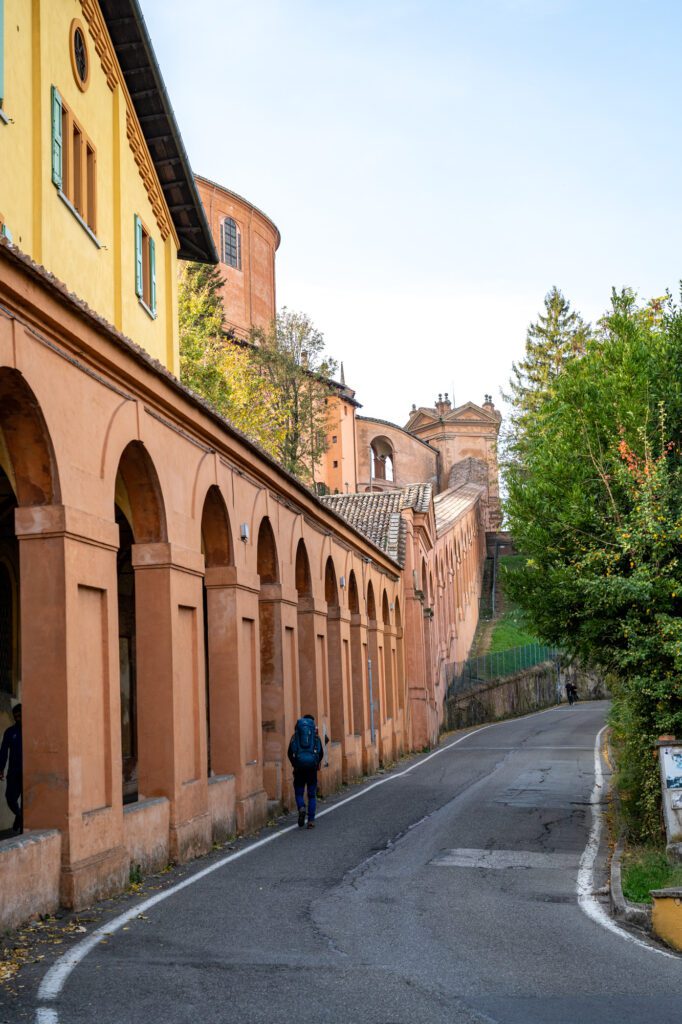
The winding porticoed walkway runs all the way from Via Saragozza on the outskirts of the city center right up to the church.
At 3.8 km in length, it’s the longest covered walkway in the world. The full walk takes around 45 minutes to an hour, depending on your pace.
As you walk up, you’ll be rewarded by many scenic viewpoints along the porticoes. But the best one has to be from the church’s dome, which has amazing panoramic views back towards Bologna and out over the hills surrounding the city.
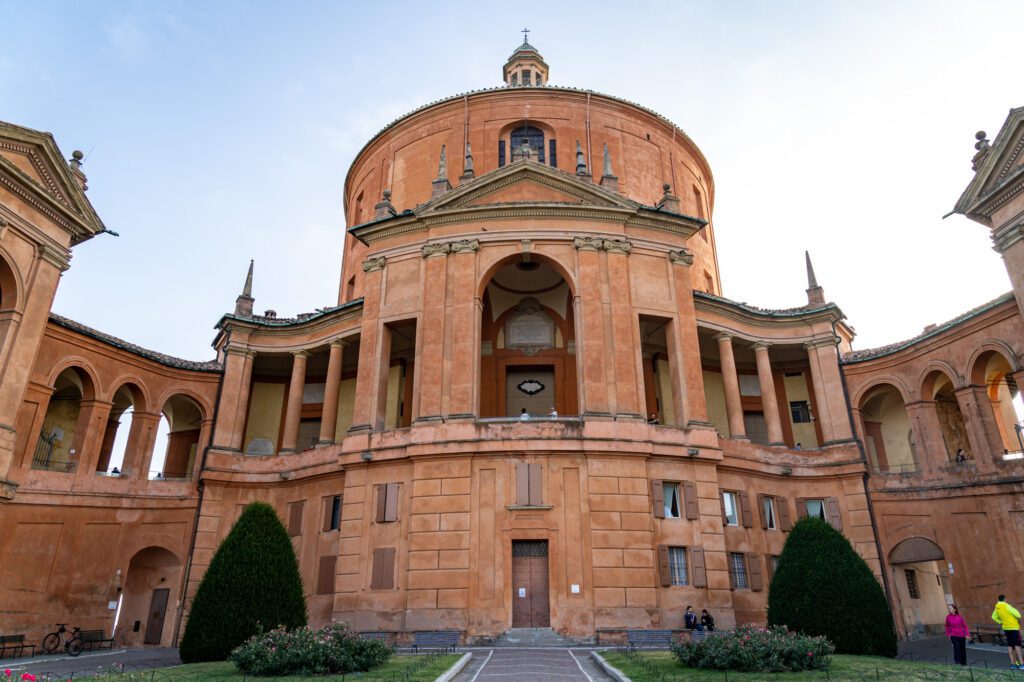
Inside the church, you can also admire the many works of art, including the sacred image of The Madonna of San Luca that gave the church its name.
If the uphill walk seems like too much, another option is to take the tourist train up and walk back down.
The San Luca Express is a small tourist train that departs from Piazza Maggiore, travels through the historic center, and up to the Sanctuary. A round ticket costs €12 per adult and €6 for kids, and includes an audio guide.
Take a Walking Tour
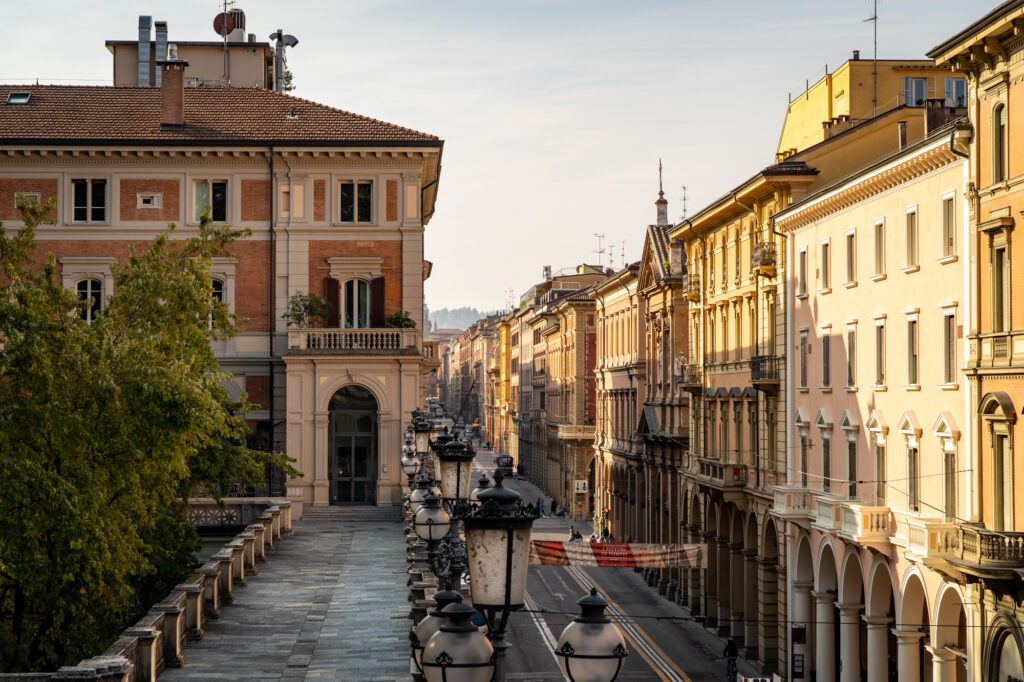
A guided walking tour is an excellent way to get to know a new city and learn about its history and culture. If you have a few days in Bologna, it’s definitely worth going on a walking tour when you first arrive.
I did this 2-hour evening tour and it was a great introduction to the city.
The tour is run by Addy, an extremely friendly and knowledgeable guide who has lived in Bologna for many years after falling in love with it during his studies.
A walking tour also gives you the opportunity to ask a local anything you want. Whether you have questions about the city’s history or you want to know the best places to party, this is your chance.
Take a Food Filled Day Trip to Reggio-Emilia
In the same way that our Douro Valley tour was the #1 highlight of our Portugal itinerary, the food tour we did to dive deep into parmigiano-reggiano cheese was the highlight of our most recent trip to Italy.
We did this organized day trip to visit a cheese producer in Reggio Emilia on our last visit to Bologna and it was incredible.
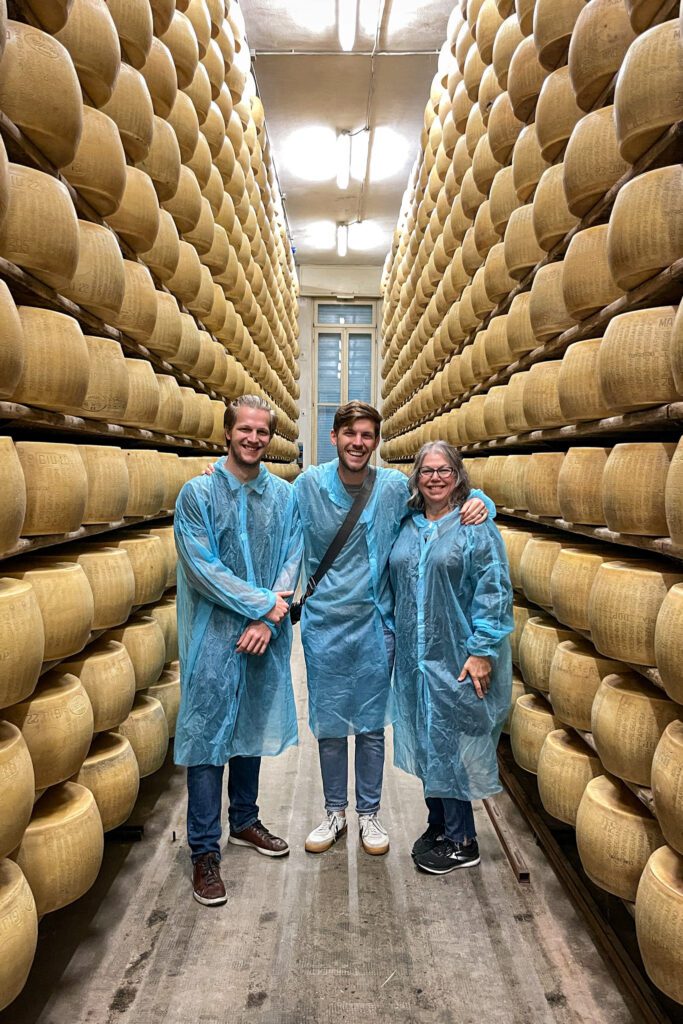
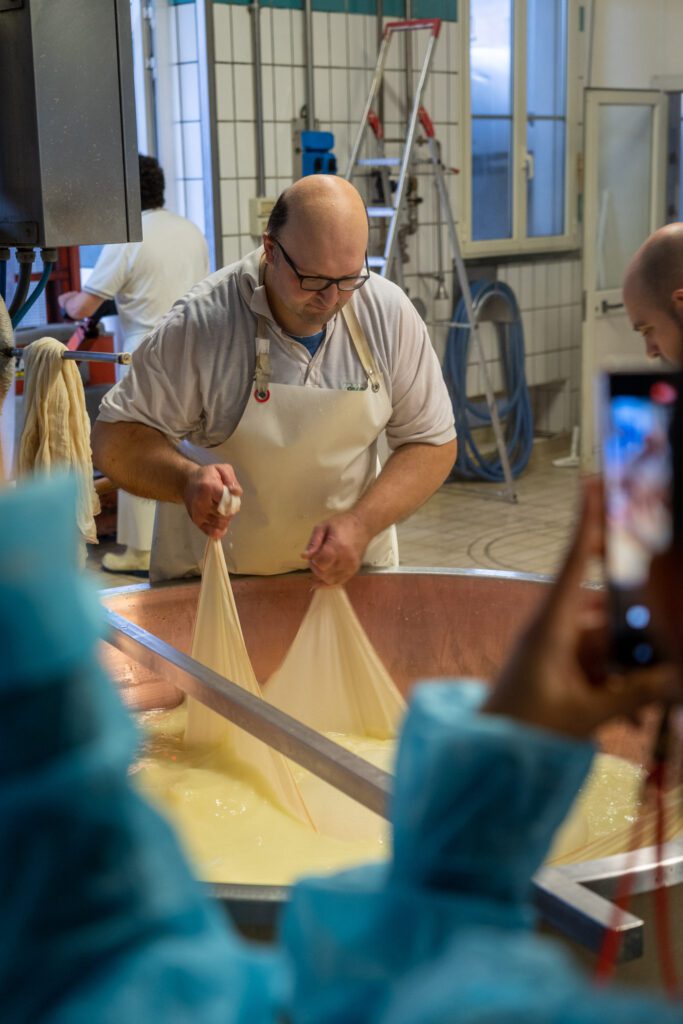
We were guided by a charismatic local host, Claudio, and learned all about the process of making Parmesan while wandering around the working factory. We even got to see the cows who make the cheese.
At the end of the tour, we got to taste various aged cheeses, plus some other products from Emilia-Romagna like balsamic vinegar, prosciutto, and Lambrusco.
AND we went home with a vacuum-packed 500g portion of cheese (which will be fine until you get home).
The tour starts from Reggio Emilia AV Station, which you can reach from Bologna in as little as 22 minutes by high-speed train (or slightly longer by regional train).
We’d highly recommend this tour for foodies in Bologna!
Take a Cooking Class
Cooking classes are a fantastic way of immersing yourself in the food culture of any place you visit. Plus learning a new skill and local recipes is one of the coolest souvenirs you can take away with you.
We’ve done cooking classes in Spain, Colombia, Mexico City, and here at home in the US. But, unfortunately, since Matt is a Celiac and can’t have even a crumb of gluten, Italy isn’t a great place for us to do it given the prevalence of pasta, pizza, and bread.
But that doesn’t mean you shouldn’t do one! And where better to take a cooking class than in the foodie capital of the world!?
This is the cooking class we’d choose if given the choice. Hosted by a local innkeeper, this small group class teaches you how to make two types of local pasta – tagliatelle and tortellini – and an authentic Bolognese ragù.
You’ll also get to taste some local wines from the Emilia-Romagna region while enjoying your delicious homemade pasta.
Catch a Bologna F.C. Game (Soccer / Football)
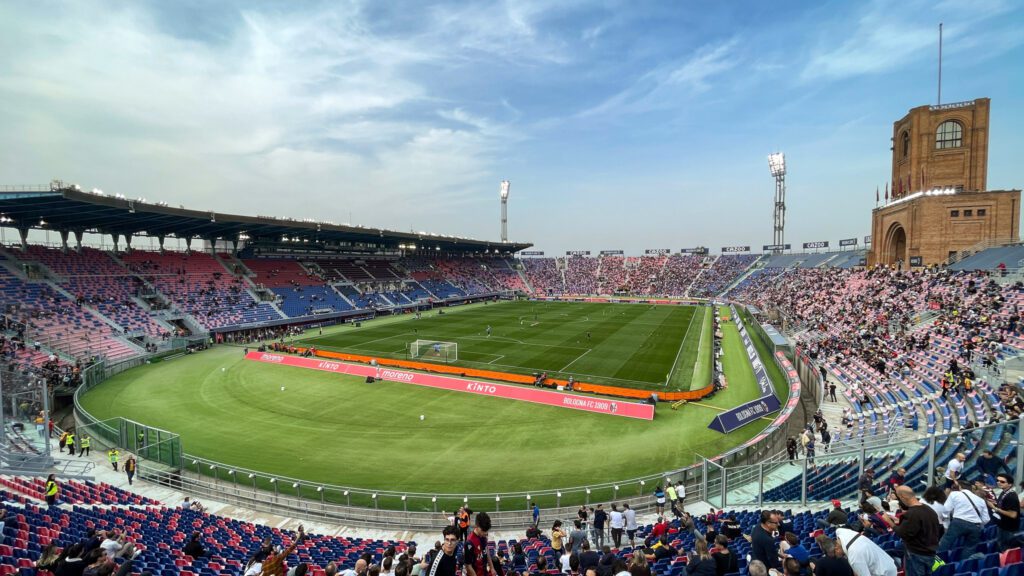
If you’re a fan of football/soccer, don’t miss the chance to see a Bologna F.C. game at the team’s historic 100-year-old stadium, Renato Dall’Ara. We went to see Bologna play during our last visit and it was an exciting and unique experience.
Bologna F.C. is currently in Italy’s Serie A, the top division in Italy, which usually runs its season between late August and late May.
You can find a list of upcoming home fixtures on the club’s website here to see if there’s a game taking place during your visit.
The stadium is located on the western outskirts of the city and can be reached by local bus in around 10-15 minutes from the center (though we walked, and it was easy enough).
You can purchase tickets at the visitor center on Piazza Maggiore, where they’ll help you buy and print them (I tried to do it myself and failed, and they were super helpful).
